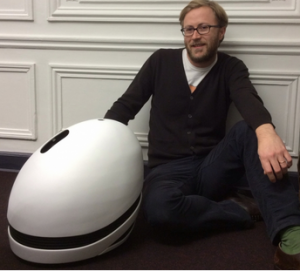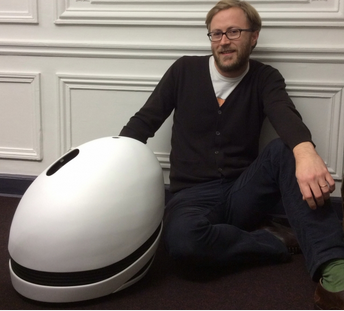We’ve crammed our apartment and offices with TVs and computer screens. And, yet, most of the time, they sit there, idle. Yes, that’s right, they’re idle when we’re not there watching and when you’re not using them. This is also true of all many different and entangled cables, which are used to charge and connect our devices together.
I/ We’ve purchased devices and failed to connect them to one another
Plus, we usually also have a hard time connecting together our various devices that we use to go online, watch movies, play games or listen to music. Apple had an ad which mentions this very issue. They talk about how the PC is unable to « talk » to a Japanese Camera.
Isn’t this absurd ? We’ve purchased all these products and we’re unable to get them to connect to one another.
Good news, folks : This time is over ! Introducing Keecker, a great disruptive product.
II/ Keecker brings greater connectivity
Keecker is a new cute rolling robot. It will enable us to use any surface in our home or office, day or night, wall or ceiling as a screen. We’ll use this to :
- Skype
- project movies
- check our mails
- surf the web
- display family pictures
- change the walls into a view of the Milky Way to make the kids go to sleep
And all this is controlled by your smartphone.
III/ Keecker brings a new immersive digital experience

The great innovation here is that Keecker blends digital screens with actual brick and mortar surfaces thanks to a projector. You won’t need a fixed TV or a fixed PC screen anymore. Even better, if you want to cook, Keecker will display the recipe on the fridge. It’s like taking the internet, movies, music and digital content out of their computer coffins and spreading them all around you in a Matrix-like immersive experience. Keecker also comes in with regular temperature and humidity sensors to monitor your house or office.
Keecker is going to really change the way we work in the digital age, just like Steve Jobs changed the computer industry in 1984 by releasing the mouse. The new Steve Jobs behind Keecker is called Pierre Lebeau, a young engineer and a former Google Product Manager, with a French flair for simplifying our lives. As Steve Jobs used to say, “technology is about amplifying a human ability”. And Keecker does just that: it blends our rooms or and gardens with digital content into digital safaris.
Keecker will be available for sale at the end of 2014. In the meantime, check it out at the CES in Las Vegas. Also, check out their corporate website: www.keecker.com

[…] autre discussion d’un produit multimédia également très innovant, veuillez vous référer à ce billet qui présente […]
[…] autre discussion d’un produit multimédia également très innovant, veuillez vous référer à ce billet qui présente […]
Wow!!!
This is a super interesting article!
Bravo!
Wow!! This is a fascinating article!
There’s hope yet to be able to neatly organize one’s home in spite of all the wires and cords!
Actually, Apple was the second company to commercialize the mouse and the first to widely popularize it. The story is broader than just the mouse, because the mouse technology both required and enabled graphical user interface technologies. See: http://en.wikipedia.org/wiki/History_of_the_graphical_user_interface .
The evolution of that is full of lessons about innovation. For example, the GUI and mouse were synergistic — each required the other (a graphical interface needs a pointing device and vice versa); Xerox developed the core technologies but, because of its marketing incompetence, failed to popularize them. Steve Jobs effectively stole the graphical user interface from Xerox and popularized it. Then Bill Gates copied it (actually stole, there was a puny legal settlement wherin Microsoft paid Apple) from Apple and ultimately gained about a 90% market share. But, his innovation was really in neither technology nor marketing, but in ruthless, predatory competition. For example, see how Microsoft crippled Word Perfect, a much better word processing program than MS Word, on Windows machines. It is fascinating how he made IBM, a much larger and richer company dependent on his MS-DOS operating system and parlayed that into dominance of the PC market. He made the PC software business more profitable than PC hardware which became a commodity with many manufacturers, whereas MS Windows enjoyed a virtual monopoly. Microsoft, I’m sure, earned far more than did IBM off of PCs. Thus, the innovation game is multi dimensional and can be played with technology, marketing, business strategy, and, probably in still other dimensions.
Commercially successful innovations generally involve some underlying change like the evolution of microprocessor power (e.g., from the point that they can run a hand calculator to the point that they can run a general purpose computer). The opening up of a large new market which this creates, for example in this situation for cheap general purpose computing, attracts firms, but the really successful ones like Microsoft may not be primarily technology savvy, i. e., creators of the underlying technology that enabled the new market. Their innovation comes in how to maximally exploit it. Another example of this is how the better marketed Oracle database system came to dominate the technically superior Ingress product.
However, successful firms tend to grow large and form themselves into bureaucracies specialized around the particular products and systems that made them successful. They become resistant to further innovation and change. It is not surprising that Microsoft has announced employee layoffs. But, I suspect that this is just a precursor of a new computing paradigm where computers perhaps are aware of the user’s context (i.e., their geographic location, who they are communicating with, past history, the user’s interests and desires, etc.) and are truly assistative devices. Such computers might also be capable of voice input and commands. We will see who the next Microsoft is, but I believe there will be one.